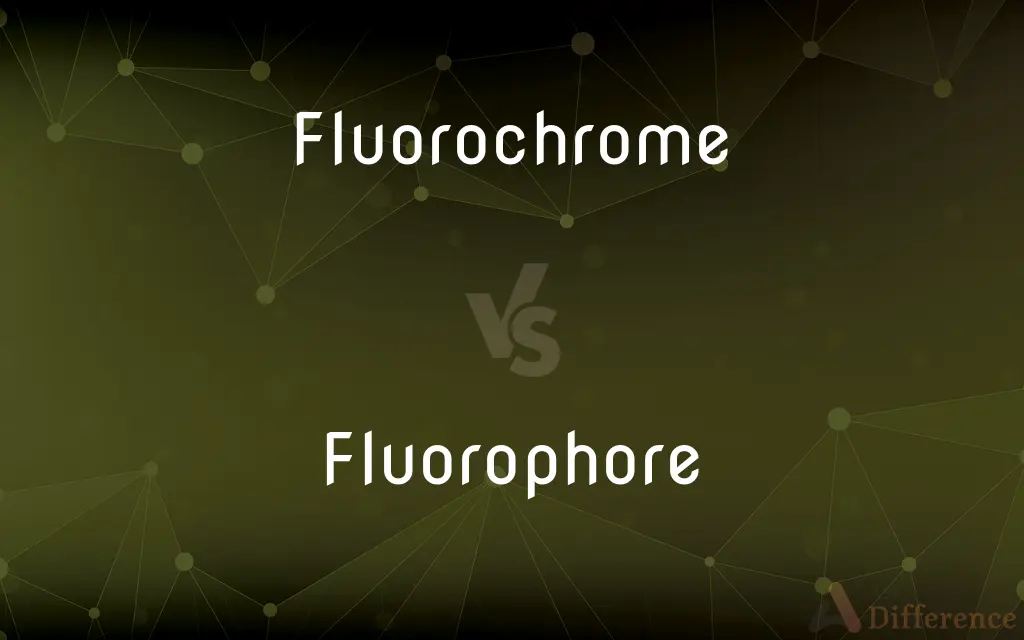Fluorochrome vs. Fluorophore — What's the Difference?
By Fiza Rafique & Urooj Arif — Updated on March 27, 2024
Fluorochrome is a broader term for any fluorescent chemical compound, used in various applications, while a fluorophore specifically refers to the part of the molecule responsible for fluorescence.

Difference Between Fluorochrome and Fluorophore
Table of Contents
ADVERTISEMENT
Key Differences
Fluorochromes are chemical compounds that can re-emit light upon light excitation, widely used in staining and microscopy to highlight structures in biological samples. On the other hand, fluorophores are the functional groups within these compounds that actually absorb and then emit light, playing a critical role in the process of fluorescence.
While fluorochromes are utilized in a range of scientific fields, including biology, chemistry, and materials science, for their ability to provide visual contrast under a microscope, fluorophores are more specifically discussed in the context of molecular and cellular biology to understand the mechanisms of fluorescence at a molecular level.
The term fluorochrome often implies a use case scenario, such as in labeling cells or tissues for fluorescence microscopy or flow cytometry, whereas fluorophores are examined in terms of their spectral properties, like absorption and emission wavelengths, to tailor specific research needs.
In the development of new fluorescent probes, the distinction between fluorochrome and fluorophore becomes important. Researchers might modify the structure of a fluorochrome to alter its properties, but it’s the fluorophore part of the molecule that primarily determines the efficiency and wavelength of fluorescence.
Understanding the difference between fluorochromes and fluorophores is crucial for designing experiments in fluorescence microscopy. The choice of fluorochrome is determined by the application's requirements, including desired brightness and photostability, while selecting a fluorophore involves considerations of quantum yield and spectral overlap.
ADVERTISEMENT
Comparison Chart
Definition
A fluorescent chemical compound.
The specific part of a molecule responsible for fluorescence.
Usage
Used broadly in labeling and microscopy.
Specifically refers to molecular fluorescence mechanisms.
Context of Discussion
Applied in a variety of scientific fields.
Discussed mainly in molecular and cellular biology.
Function
Provides visual contrast under a microscope.
Absorbs and emits light.
Importance in Research
Chosen based on application requirements.
Selected for spectral properties and efficiency.
Compare with Definitions
Fluorochrome
Chemical compounds that emit light upon excitation.
Rhodamine is a fluorochrome that emits red light.
Fluorophore
A focus for understanding fluorescence mechanisms.
Studying fluorophores helps elucidate how light absorption and emission occurs.
Fluorochrome
A substance used in flow cytometry to tag cells.
The fluorochrome PE is widely used for its bright fluorescence.
Fluorophore
The component of a fluorochrome that emits light.
The fluorophore in GFP absorbs blue and emits green light.
Fluorochrome
A fluorescent dye used to stain biological specimens.
Fluorescein is a fluorochrome used in microbiology for staining bacteria.
Fluorophore
Integral to the development of fluorescent probes.
Researchers target the fluorophore for enhanced photostability.
Fluorochrome
Plays a key role in diagnostic and research applications.
Fluorochromes are essential for identifying specific proteins in cells.
Fluorophore
Altered to change fluorescence properties.
Modifying the fluorophore can shift the emission wavelength.
Fluorochrome
Used in molecular biology to visualize cellular components.
DAPI is a fluorochrome that binds to DNA.
Fluorophore
Responsible for the specific wavelengths of light emitted.
The fluorophore's structure determines its emission spectrum.
Fluorochrome
A chemical that fluoresces, especially one used as a label in biological research.
Fluorophore
A fluorophore (or fluorochrome, similarly to a chromophore) is a fluorescent chemical compound that can re-emit light upon light excitation. Fluorophores typically contain several combined aromatic groups, or planar or cyclic molecules with several π bonds.Fluorophores are sometimes used alone, as a tracer in fluids, as a dye for staining of certain structures, as a substrate of enzymes, or as a probe or indicator (when its fluorescence is affected by environmental aspects such as polarity or ions).
Fluorochrome
Any of a group of molecules that exhibit fluorescence and are often used as biological stains or are attached to proteins or other substances to serve as probes.
Fluorophore
Any group of atoms whose presence in a molecule causes the molecule to be fluorescent.
Fluorochrome
Any of various fluorescent dyes used to stain biological material before microscopic examination
Fluorophore
Any fluorescent compound.
Fluorochrome
Any of various fluorescent substances used in fluorescence microscopy to stain specimens.
Fluorophore
A fluorochrome that is conjugated with a protein or other macromolecule and used as a probe or assay.
Fluorochrome
Any of various fluorescent substances used in fluorescence microscopy to stain specimens
Fluorophore
Any of various chemical groups or structural domains that are responsible for the fluorescent properties of a substance.
Fluorophore
(biochemistry) A molecule or functional group which is capable of fluorescence.
Common Curiosities
What is a fluorophore?
A fluorophore is the specific part of a fluorescent molecule that is responsible for its ability to absorb and then emit light.
How do fluorochromes work?
Fluorochromes absorb light at one wavelength and emit light at a longer wavelength, providing visual contrast in microscopy.
What is a fluorochrome?
A fluorochrome is a fluorescent chemical compound that can re-emit light upon light excitation.
What is the role of fluorochromes in biological research?
Fluorochromes are used in biological research to stain cells and tissues for visualization under fluorescence microscopy and in assays.
Can the terms fluorochrome and fluorophore be used interchangeably?
While related, the terms are not interchangeable; fluorochrome refers to the entire fluorescent molecule, while fluorophore refers specifically to the part of the molecule responsible for fluorescence.
How do fluorochromes and fluorophores contribute to medical diagnostics?
They enable the visualization of specific components within biological samples, aiding in the diagnosis of diseases.
Why are fluorophores important in fluorescence?
Fluorophores are crucial because they determine the spectral properties of fluorescence, such as absorption and emission wavelengths.
How are fluorophores used in creating fluorescent probes?
Fluorophores are engineered within probes to target specific molecules or conditions within cells, enabling targeted fluorescence.
How does the structure of a fluorophore affect its fluorescence?
The structure of a fluorophore affects its electronic properties, determining its absorption and emission wavelengths and efficiency.
Why is the photostability of a fluorophore important?
Photostability determines how long a fluorophore can emit light before degrading, affecting the duration and quality of fluorescence imaging.
What considerations are important when selecting a fluorochrome for an experiment?
Considerations include the fluorochrome's excitation and emission spectra, compatibility with the detection equipment, and the biological sample.
What are some common applications of fluorophores?
Common applications include molecular biology research, medical diagnostics, and the development of biosensors.
What are the benefits of using fluorochromes in flow cytometry?
Fluorochromes allow for the identification and quantification of specific cell populations based on fluorescence.
What makes a good fluorochrome for microscopy?
Good fluorochromes for microscopy have high brightness, photostability, and are compatible with the specimen and microscopy setup.
How can the fluorescence of a fluorophore be quantified?
The fluorescence of a fluorophore can be quantified by measuring its quantum yield and brightness, which are influenced by its absorption and emission characteristics.
Share Your Discovery

Previous Comparison
Orbital vs. Orbit
Next Comparison
Murked vs. MerkedAuthor Spotlight
Written by
Fiza RafiqueFiza Rafique is a skilled content writer at AskDifference.com, where she meticulously refines and enhances written pieces. Drawing from her vast editorial expertise, Fiza ensures clarity, accuracy, and precision in every article. Passionate about language, she continually seeks to elevate the quality of content for readers worldwide.
Co-written by
Urooj ArifUrooj is a skilled content writer at Ask Difference, known for her exceptional ability to simplify complex topics into engaging and informative content. With a passion for research and a flair for clear, concise writing, she consistently delivers articles that resonate with our diverse audience.















































